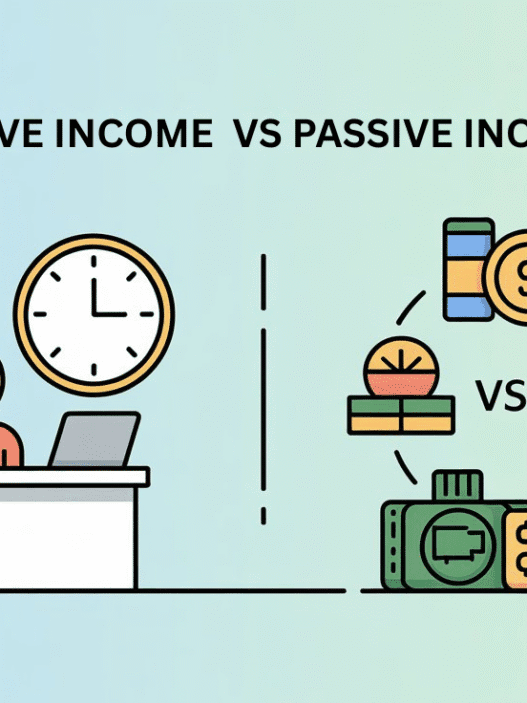Why Two People Can Earn the Same but Keep Very Different Amounts
Not all money is taxed equally. In fact, two people can both earn $200,000 in a year and still end up with a massive gap in what they actually take home. The difference often comes down to how they earned it. One might pay nearly half in taxes, while the other keeps most of it and it has nothing to do with tax evasion or shady loopholes.
The secret lies in understanding the earned income vs capital gains. One is taxed heavily because it’s linked to labor. The other is treated far more generously because it’s tied to ownership and investment growth.
This knowledge is why founders, real estate moguls, and long-term investors seem to build wealth so much faster than the average employee. While most people trade time for money, the wealthy focus on building and holding assets that increase in value and when they cash out, the tax bill is surprisingly light.
In this article, we’ll break down:
- What capital gains really are
- How they differ from wages and salaries
- Why the tax code rewards investment growth over hard work
- Real examples showing the wealth gap this creates
- How everyday people can start benefiting from these rules
1. Three Main Types of Income – And Why They’re Not Treated Equally
The U.S. tax code doesn’t lump all income into one category. Broadly speaking, there are three main types of income:
- Earned Income – Wages, salaries, freelance payments, and business profits from active work.
- Tax rate: Up to 37% in federal income tax (as of 2024), plus payroll taxes (Social Security and Medicare) totaling 15.3% for the self-employed.
- Portfolio Income – Profits from selling investments such as stocks, bonds, or real estate (capital gains), as well as certain dividends.
- Long-term capital gains (assets held over one year) are taxed at just 0%, 15%, or 20% depending on income with no payroll taxes.
- Passive Income – Rental income, royalties, or income from limited partnerships.
- Often benefits from deductions like depreciation, lowering the taxable amount.
This structure means the very same dollar amount can be taxed in completely different ways depending on its source.
2. The $200,000 Example – Earned Income vs Capital Gains

Let’s put this into numbers.
Scenario A: High-Paid Professional
- Income: $200,000 from a job (doctor, lawyer, executive, etc.)
- Federal income tax: Around $45,000 (effective rate 24–32%)
- Payroll taxes: $15,300 if self-employed (or split with an employer)
- Total taxes: About $60,000
- Net income: ~$140,000
Scenario B: Long-Term Investor
- Income: $200,000 from selling stocks held for more than a year
- Capital gains tax (15% bracket): $30,000
- Payroll taxes: $0
- Total taxes: $30,000
- Net income: $170,000
That’s a $30,000 difference just because of how the money was earned.
3. Why the Wealthy Love Capital Gains
The rich don’t just “get lucky” with taxes they plan their income streams to take advantage of capital gains rates.
Common strategies include:
- Taking equity instead of salary – Startup founders often accept minimal pay but receive shares in their company. When the company sells or goes public, profits are taxed at capital gains rates instead of income tax rates.
- Buy, Borrow, Die – Wealthy individuals hold appreciating assets, borrow against them for cash (loans aren’t taxable), and pass them on to heirs who receive a stepped-up cost basis, avoiding capital gains tax altogether.
- Qualified Small Business Stock (QSBS) – U.S. law allows up to $10 million in tax-free gains when selling qualifying small business shares under certain conditions.
These methods aren’t available to everyone, but they highlight how deeply the system favors ownership over labor.
4. The Warren Buffett Example

Warren Buffett, one of the world’s most famous investors, once revealed that he paid just 17.4% in taxes on $62 million of income. His secretary, meanwhile, paid a rate between 33% and 41%.
Why? Buffett’s income came almost entirely from capital gains and dividends, not a paycheck. The same strategy is used by many tech founders and real estate tycoons they minimize salaries, build wealth in assets, and sell when the tax impact is smallest.
5. How Capital Gains Work – The Basics

Capital gains are the profit you make from selling an asset for more than you paid for it.
- Short-Term Capital Gains – Assets held less than 12 months. Taxed like ordinary income.
- Long-Term Capital Gains – Assets held more than 12 months. Taxed at 0%, 15%, or 20% depending on income.
Example:
- You invest $100,000 in the S&P 500.
- After 5 years, it grows to $180,000.
- Your gain is $80,000.
- If your income puts you in the 15% capital gains bracket, you’ll pay $12,000 in tax.
Compare that to earning $80,000 from a job you’d likely owe $13,000–$17,000 in combined taxes and you’d have worked full-time to earn it.
6. Extra Perks for Investors
Investors also enjoy tax benefits such as:
- Capital Loss Offsetting – Sell losing investments to reduce your taxable gains.
- Depreciation Deductions – Real estate investors can deduct part of the property’s value each year.
- Dividend Tax Breaks – Qualified dividends are often taxed at the same low rates as long-term capital gains.
7. The Historical Reason Behind Low Capital Gains Taxes
In 1921, the U.S. government wanted to encourage people to invest in businesses, real estate, and land. High taxes on investment profits discouraged this, so lawmakers introduced lower rates for capital gains.
While the goal was economic growth, it has also widened the gap between those who work for money and those whose money works for them.
8. Global Perspective – Other Countries Do It Too
This isn’t just a U.S. phenomenon. Many countries reward investment over labor:
- UK – Capital gains taxed at 10–20%, usually lower than income tax.
- Germany – Hold assets over 1 year and you pay no capital gains tax on some investments.
- Australia – 50% discount on capital gains held more than 12 months.
- Singapore – No capital gains tax at all.
In many developed nations, top income tax rates exceed 40%, making the gap between labor and capital even larger.
9. The Changing Nature of Wealth
Over recent decades, wealth has shifted from wages to ownership.
- In 1970, U.S. workers received 64% of total national income.
- By 2023, that dropped below 59%.
Meanwhile, asset prices especially stocks have skyrocketed. The S&P 500 grew over 1,600% since 1990, while average wages (after inflation) rose just 18%.
10. Technology Is Accelerating the Shift
Automation and artificial intelligence are replacing jobs faster than ever. A 2024 survey found 1 in 4 workers fear their job will disappear within 5 years. Even creative and tech roles are being automated.
Assets, on the other hand, don’t get tired, sick, or outdated in the same way. They can generate income every day without your ongoing labor.
11. The Numbers Don’t Lie
A 2023 IRS report showed that in households earning over $1 million annually, only 17% of their income came from wages. The rest was from:
- Capital gains
- Dividends
- Business ownership
- Investments
12. The Takeaway – Build Ownership, Not Just Paychecks
Jobs are essential for starting out, but relying solely on earned income makes it much harder to get ahead. Taxes take a bigger bite, and your income is tied to your time and health.
Long-term wealth and freedom come from owning things that make money without your daily effort stocks, rental properties, businesses, intellectual property, and more.
The tax system rewards these forms of income, and the sooner you start shifting toward them, the faster you can reduce your tax burden and grow your wealth.

In the modern economy, the future belongs to owners, not just workers. You don’t need to be a billionaire to take advantage of this you just need to start moving part of your earnings into assets that can grow over time. Every dollar you shift from labor to capital is a dollar the tax code will treat more kindly.
If you enjoyed this guide and want more insights on money, investing, and building wealth, visit Forcefall.com for more in-depth articles and resources.















